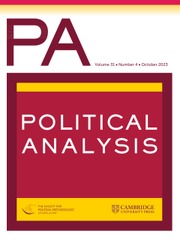Article contents
A Continuous-Time, Latent-Variable Model of Time Series Data
Published online by Cambridge University Press: 04 January 2017
Abstract
Many types of time series data in political science, including polling data and events data, exhibit important features'such as irregular spacing, noninstantaneous observation, overlapping observation times, and sampling or other measurement error'that are ignored in most statistical analyses because of model limitations. Ignoring these properties can lead not only to biased coefficients but also to incorrect inference about the direction of causality. This article develops a continuous-time model to overcome these limitations. This new model treats observations as noisy samples collected over an interval of time and can be viewed as a generalization of the vector autoregressive model. Monte Carlo simulations and two empirical examples demonstrate the importance of modeling these features of the data.
Information
- Type
- Articles
- Information
- Copyright
- Copyright © The Author 2015. Published by Oxford University Press on behalf of the Society for Political Methodology
Footnotes
Author's note: The author wishes to thank John Ahlquist, Patrick Brandt, Kosuke Imai, Simon Jackman, Jon Krosnick, Suzanna Linn, Jon Pevehouse, James Sieja, Susannah Tahk, David Weimer, and participants at Princeton University's Political Methodology Research Seminar and the 28th Annual Meeting of the Society for Political Methodology. Supplementary materials for this article are available on the Political Analysis Web site.
References
- 4
- Cited by

